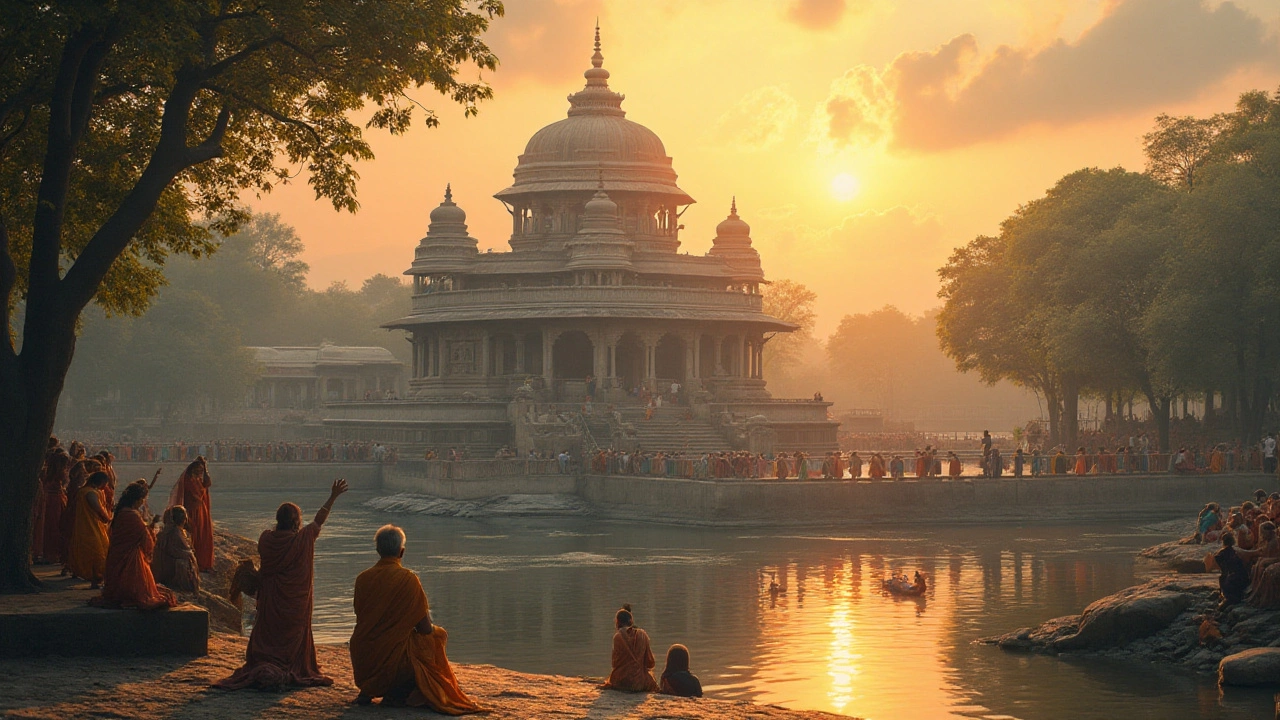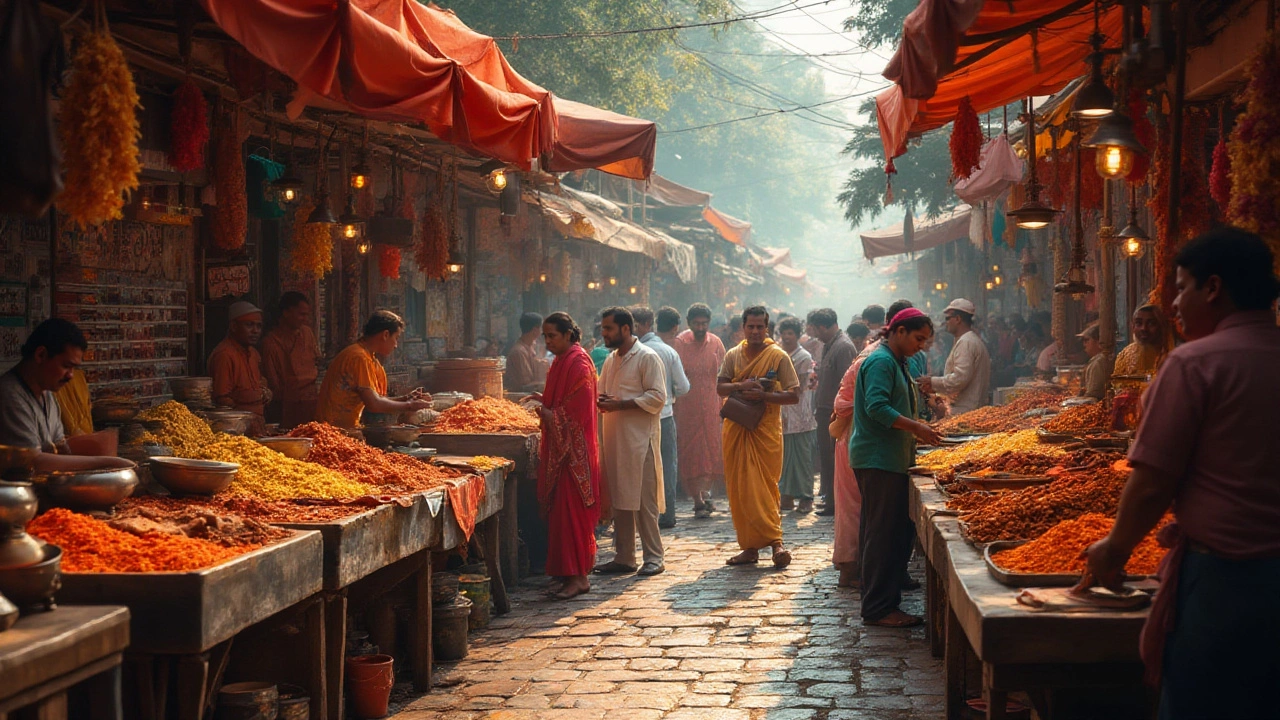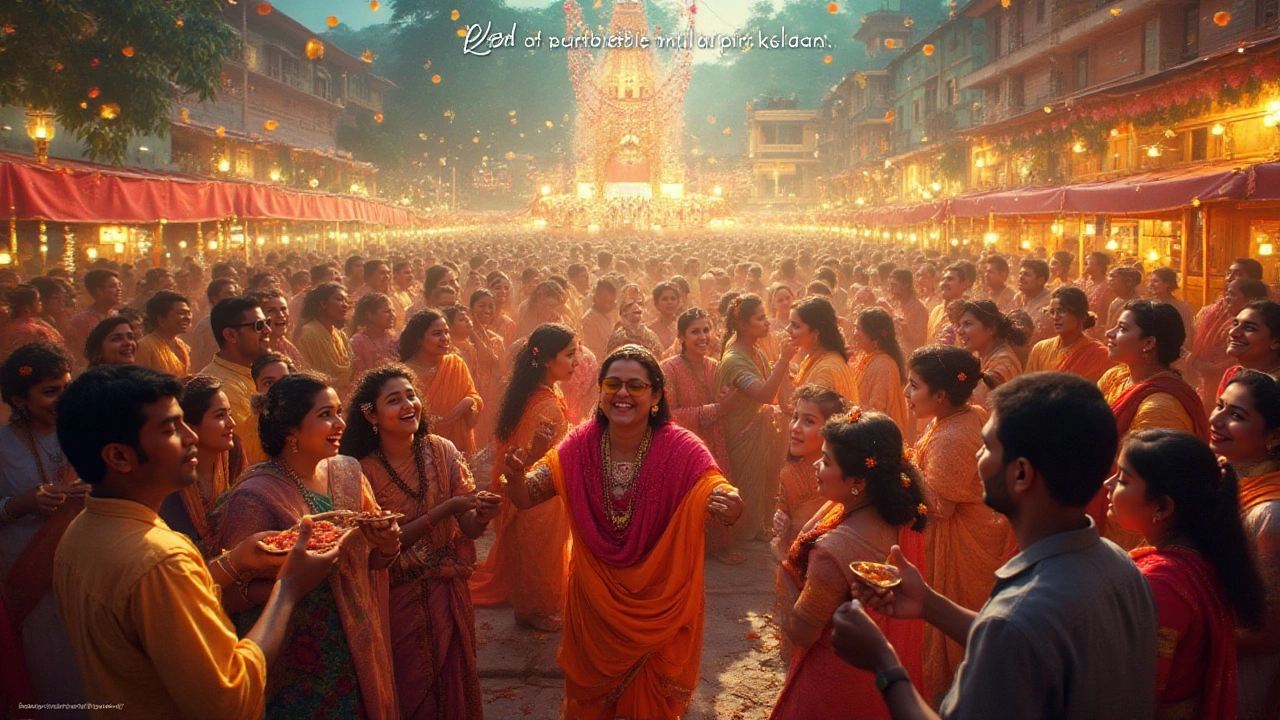India is a land where the past and present blend seamlessly, each layer revealing a story of its own. To say Indian is merely a culture or religion would restrict one’s view of a place so deep and varied. Instead, India's identity is a harmonious symphony of both cultural and spiritual elements, woven together through time.
This vast country functions as a melting pot of countless traditions, languages, and beliefs, each contributing to the vibrancy that characterizes Indian life. Across its breadth, people partake in colorful festivals, speak a myriad of languages, and practice age-old customs reflected in art, music, and daily life. While religion plays a significant role, manifesting through practices centered around Hinduism, Islam, Christianity, and others, it is the intersectionality with culture that truly defines what it means to be Indian.
In this exploration, we dive into the multifaceted dimensions of India to better understand how its culture encompasses religion, and how both elements work in tandem to create a uniquely rich tapestry that stands resilient and influential on the global stage.
- The Complexity of Identity
- Cultural Practices Across Regions
- Major Religions in India
- Festivals and Traditions
- Diverse Expressions in Art and Cuisine
- India's Global Cultural Influence
The Complexity of Identity
India's identity is a kaleidoscope, an intricate mosaic where countless hues of cultures and religions blend, yet maintain their individuality. This complexity is not just a reflection of its ancient history but a testament to its ability to absorb and transform influences across time. Each state, city, and village in India tells its own story, contributing to the larger narrative of what being Indian means. From the snowy peaks of the Himalayas to the sun-kissed beaches of Kerala, local customs and traditions create pockets of unique cultural experience. This geographic diversity has helped cultivate a rich tapestry of practices and beliefs, fostering tolerance and adaptability among its people.
At the heart of India's multifaceted identity lies a historical narrative that intertwines empires, invasions, and migrations. The Harappan civilization, followed by a succession of rulers like the Mauryas, Guptas, Mughals, and the British, each left a unique imprint, shaping India's cultural and religious landscape. With over 1,600 spoken languages and dozens of recognized scripts, communication diversifies across the subcontinent. This linguistic variety is a powerful reminder of India's multi-layered identity. While Hindi and English serve as official languages, regional dialects and languages hold formidable cultural significance.
Religion plays an undeniably significant role in shaping Indian identity; however, it is the intersection of this spirituality with cultural practices that births the profound Indian ethos. Major religions such as Hinduism, Islam, Christianity, Sikhism, and Buddhism each contribute values, traditions, and philosophies. These faiths not only coexist but often intertwine in cultural practices. Celebrations like Diwali, Eid, Christmas, and Gurpurab offer a glimpse into how religious diversity enhances shared cultural experiences. In the words of Mark Twain, "India is, the cradle of the human race, the birthplace of human speech, the mother of history, the grandmother of legend, and the great-grandmother of tradition." This richness of spirit defines India's complex identity.
Apart from religion, regional art forms, music styles, and traditional clothing, exemplify the nation's non-verbal mode of expression. They provide insight into cultural evolution and highlight societal values. The sari draped elegantly by women in South India differs in its style and appearance from one worn in the north, yet both speak a common language of grace and heritage. Similarly, the classical dance forms of Bharatanatyam, Kathak, and Kathakali narrate epic stories, bringing together myth and art, embodying how culture remains a dynamic entity, responsive yet rooted.
Modern India's challenges often revolve around reconciling tradition with contemporary demands. Urbanization brings a blend of ideas and values, influencing lifestyle and identity. As India engages more deeply with globalization, younger generations face the dual challenge and opportunity of integrating heritage with modernity. The thriving Indian diaspora worldwide serves as cultural ambassadors, showcasing how Indian identity transforms yet retains its essence when mingled with diverse global cultures. The fusion of Indian elements in world music, fashion, and cinema speaks to a global appreciation, offering a new layer to India's complex cultural identity.
Through unity in diversity, India embodies a profound lesson about cohabitation, resilience, and coexistence. Its intricate identity, the result of a rich historical tapestry and a vibrant present, stands as a reminder that identity can be both singular and multifaceted, where the local and the global, the past and the future, all find a harmonious existence.
Cultural Practices Across Regions
India's cultural practices are as varied as its landscape, stretching from the snow-clad mountains of the Himalayas to the sun-drenched beaches of the southern coastline. Each region boasts its own distinct customs and traditions, deeply rooted in history yet dynamically evolving over time. As one traverses the length and breadth of the country, they encounter a wealth of cultural expressions that paint a vivid portrait of Indian life. The north, for instance, is often regarded as the heartland of the ancient Vedic traditions, where elaborate rituals and festivals still echo the teachings of the Rigveda and the Upanishads. In contrast, the south harbors the rich legacy of the Dravidian civilization, manifesting prominently in its classical dance forms like Bharatanatyam and its temple architecture.
The east offers a fascinating mosaic of tribal and mainstream practices, where communities like the Bodos in Assam uphold their distinct lifestyle while participating in broader Indian festivals. In juxtaposition, the western part of India, with states like Maharashtra and Gujarat, brings forth a vibrant tapestry of colors through its fabric art and crafts, along with a culinary scene that reflects a marriage of coastal flavors and agrarian bounty. The intricate work of block printing in Rajasthan or the elaborate art of Warli paintings tells stories of age-old traditions adapted by contemporary artisans. To understand this immense diversity, one must engage with these practices firsthand, joining in local celebrations and participating in daily rituals which are often geared around agricultural cycles and religious observances.
The shared customs across regions provide a sense of unity amid diversity, an ethos deeply ingrained in the Indian psyche. Festivals like Diwali and Holi are celebrated with equal zeal in every corner, each region adding its unique twist to the festivities.
"India is an amalgamation of unity in diversity," noted noted historian Girish Karnad, encapsulating the essence of how regional differences merge into a singular national identity.Such celebrations are windows into the spirit of Indian homes, where traditional attires, music, and dance take center stage, revealing the cultural wealth that enriches everyday life. It is through these regional practices that one uncovers the essence of Indian culture, an intricate blend of past and present, showing a nation's ability to uphold its heritage while embracing change.

Major Religions in India
The spiritual landscape of India is as vast and varied as the country itself. India is the birthplace of several major religions, including Hinduism, Buddhism, Jainism, and Sikhism, which have long been woven into the cultural fabric of the nation. Hinduism, as the oldest religion in the world, forms the backbone of religious practices for the majority of the population. It's not just a unified system of beliefs but a diverse and dynamic web of scriptures, rituals, and philosophies. People across the country follow diverse practices and celebrate numerous festivals that bring communities together despite their numerous differences.
Another religion that originated in India is Buddhism. Founded by Gautama Buddha in the 6th century BCE, Buddhism rapidly spread beyond Indian borders and became a global faith. While today, India's Buddhist population forms a small portion of the populace, the legacy of Buddha's teachings endures in cultural and historical sites, such as Bodh Gaya and Sarnath, which draw pilgrims and tourists alike. Jainism, although lesser-known internationally, offers another perspective of ancient Indian spirituality. Emphasizing non-violence and truth, Jainism's impact is profound, especially in regions like Rajasthan and Gujarat, where magnificent Jain temples showcase intricate artistry.
Sikhism, born in the Punjab region in the 15th century, is notable for its emphasis on equality, community service, and devotion to one God. The Golden Temple in Amritsar stands as a testament to this faith's principles and is one of India's most visited religious sites, fostering spiritual reflection and service to humanity. Islam, brought to India through various conquests and trade, is currently the second largest religion, contributing significantly to India's cultural fabric. Its influence is visible in architecture, art, food, language, and greater societal structures across the country. Christianity also holds a notable presence, with communities spread from Kerala to the northeastern states, where historical churches speak of ancient and modern stories of devotion.
India's religious tapestry is incomplete without mentioning its pluralistic nature, where diverse beliefs coexist peacefully. This harmony is a defining feature of Indian society, bridging gaps between different faiths through interfaith dialogues and shared cultural respect. Mahatma Gandhi once remarked, "I am a Hindu, I am a Muslim, I am a Christian, I am a Jew, and so are all of you."
Gandhi's vision of religious coexistence highlights the overarching ethos of the country, where diversity is celebrated rather than merely tolerated.Such beliefs ensure that while the religions of India are distinct, they also interweave to create a colorful and harmonious society.
Festivals and Traditions
The widespread diversity of Indian culture is most vibrantly reflected through its festivals and traditions. These celebrations are not just merry occasions; they are an embodiment of India's spiritual and social consciousness, showcasing unparalleled pomp and grandeur. Each region, every religion, carries its own blend of festivals, yet they share a common thread—a profound sense of community and continuity with the past. Diwali, often called the Festival of Lights, lights up the entire country in a blaze of oil lamps, fireworks, and social gatherings. The festival represents the triumph of light over darkness and knowledge over ignorance. Coupled with rituals and sweets, it creates memories cherished by families for generations.
Another significant festival is Holi, the Festival of Colors, celebrated with a riot of colors and joyous water fights in the spring. It brings people from different walks of life together, bypassing social discriminations and fostering unity. This celebration symbolizes the arrival of spring and the victory of good over evil. The historical accounts of Holi are interwoven with stories from Hindu mythology, primarily involving the playful antics of Lord Krishna with the gopis, placing cultural narratives at the forefront of these celebrations.
"India is a country in which every great religion finds a home," eloquently stated by Annie Besant, perfectly encapsulates this aspect of Indian life where multiple faiths contribute to a rich tapestry.
Each state and community in India also celebrates its unique festivals, such as Pongal in Tamil Nadu, a harvest festival that binds the farming community, or Durga Puja in West Bengal, which is not just a religious event but a cultural landmark involving arts, competitions, and community service. Meanwhile, the famous Onam festival in Kerala attracts tourists worldwide, eager to witness its elaborate elephant processions and traditional dance called Kathakali. Such festivals are steeped in tradition and yet are dynamic, evolving with the times to maintain their cultural relevance.
Traditions in India can be observed in daily rituals, family gatherings, and even how specific foods are consumed. Each meal can be a tradition in itself, with diverse expressions in art and cuisine at play. Traditional Indian attire like sarees and dhotis worn during festivals enhances the sensory experience of celebrations. Despite modernization and globalization, these traditions endure, connecting people to their roots. They also act as a bridge, educating the younger generations about their heritage and the socio-cultural values that have shaped their communities.
The role of music and dance in festivals cannot be overlooked, as they form an integral part of the experience. From the classical Bharatnatyam performances during Navratri to the folk dances like Garba in Gujarat, the rhythmic beats and graceful movements transcend mere performance. They serve to preserve Indian cultural heritage, interpreted through the prism of history, myth, and the human condition.

Diverse Expressions in Art and Cuisine
India's magnificent **cultural heritage** offers an immersive tapestry of artistic expression and culinary innovation, rooted deeply in its vibrant history and varied geography. The art forms of India range from the intricate designs of Madhubani painting from Bihar, with its delicate strokes that often depict stories from Hindu mythology, to the grandeur of classical dance forms like Bharatanatyam from Tamil Nadu, where every gesture tells an age-old tale. These art forms are not static; they evolve, absorbing contemporary influences while maintaining their traditional essence. In this way, India's art is a dialogue between the past and the present, resonating with meaning and narrative.Indian culture is not monolithic; it reflects the diversity of the regions, shaped by different historical influences. In Rajasthan, for instance, the colorful and elaborate Rajasthani murals and miniatures tell the stories of royalty and valor. Meanwhile, in South India, the intricate stone carvings of temples speak volumes of the devotion and artistic proficiency of ancient sculptors, their work enduring as a testament to the era’s aesthetic and spiritual aspirations.
When it comes to **Indian cuisine**, it is a celebration of flavors, a beautiful confluence of spices, textures, and cooking techniques that vary from one region to another. The food ranges from the rich, creamy dishes of the North, such as butter chicken and paneer tikka, to the rice and coconut-based delicacies of the South, like dosa and coconut chutney. Each region, with its unique ingredients and distinctive climate, contributes myriad tastes and aromas, making Indian cuisine a profound expression of the country's **cultural diversity**. It is said that Indian cuisine is the mother of all flavors, and many renowned chefs attribute this to the bold use of spices like cumin, coriander, turmeric, and chilies, which not only enhance the taste but also offer health benefits.
Indian art and cuisine are interwoven with the fabric of everyday life, influencing celebrations, religious rituals, and family gatherings. “To understand Indian art and cuisine is to gain deeper insight into the spirit of the people,” notes acclaimed historian William Dalrymple.
“Much like our lives, our food and art are defined not by a single stroke or taste but by the myriad experiences we carry with us,”he eloquently observed, capturing the essence of how these diverse expressions anchor communal identity and continuity. In examining India's artistic and culinary landscape, one cannot help but be captivated by the range and depth of expression—a testament to its historical evolution and openness to external influences.
India's Global Cultural Influence
When you think about Indian culture, you can't ignore its growing presence on the global stage. With its rich tapestry of traditions, languages, and beliefs, India has left an indelible mark on the world. From Bollywood’s colorful and exuberant productions lighting up screens everywhere, to the aromatic allure of Indian cuisine transforming taste buds across continents, India’s cultural footprint is visible everywhere.
Take, for instance, the enduring popularity of yoga, which has its roots deep in Indian spiritual practice and philosophy. This ancient discipline has seen a massive international uptake, with practitioners forced online initially due to Covid-19 restrictions, but leading to a digital boom that made yoga more accessible worldwide. The International Day of Yoga, observed annually since 2015, highlights this global fascination and the desire for well-being techniques originating from India.
"Yoga is the journey of the self, through the self, to the self." - The Bhagavad Gita
Indian cuisine, too, has enticed the global palate, with its diverse flavors and vibrant spices becoming staples in kitchens far beyond the subcontinent. Dishes like chicken tikka masala and samosas can be found from London to Sydney, making Indian culture a readily available experience in several parts of the world. Cooking shows and food festivals dedicated to this culinary tradition showcase how deeply integrated Indian gastronomy has become around the globe.
The influence extends to music as well, with Indian classical styles melding with Western pop and electronic genres to create unique and compelling fusion sounds. Artists from the Beatles to Norah Jones have drawn inspiration from Indian music, illustrating the cross-cultural exchanges that enrich the world of music. From sitar duets with Western orchestras to Bollywood soundtracks winning global accolades, India’s sonic contributions echo far and wide.
Fashion is another vibrant thread in the tapestry of India’s global cultural influence. With Indian designers showcasing at prestigious fashion weeks and the textiles like silk and cotton highly coveted globally, the blending of traditional Indian attire with contemporary styles has been revolutionary. India's dyeing and weaving techniques are centuries-old arts that underpin a growing appreciation for slow fashion and sustainable practices worldwide - a timely contribution in an era of eco-consciousness.
Considering cinema, the Bollywood industry is one of the largest in the world, producing more films than any other. Its narratives, infused with dramatic flair and musical elements, have a dedicated following across Africa, Russia, and the Middle East. In recent years, the global reach of Indian cinema has expanded with digital streaming services, offering international audiences instant access to Indian stories.
The Future of India's Global Interaction
As we look to the future, India’s influence is set to grow. Its technological sector, with companies like Infosys and TCS, is not only boosting economic clout but spreading India’s innovative spirit across the globe. The 'Make in India' initiative continues to bolster its manufacturing capabilities, blending traditional craftsmanship with modern efficiencies, further strengthening India's place on the global stage.
In an interconnected world, the cross-cultural pollination that results from digital proliferation ensures that Indian culture remains not just a part of global heritage but a shaping force in international cultural trends. Festivals like Diwali and Holi are celebrated worldwide, symbolic of harmony and the vibrancy that Indian culture effortlessly propagates. With every yoga pose struck, every curry savored, and every Bollywood film cheered, the world becomes just a little bit more Indian, forging a tapestry of connection and shared experience.
